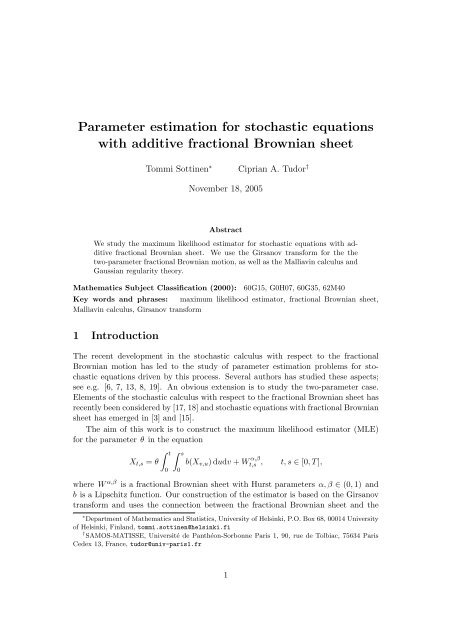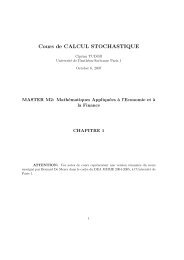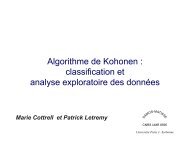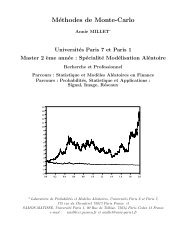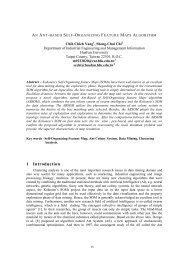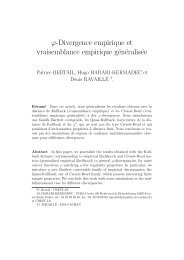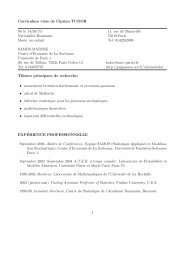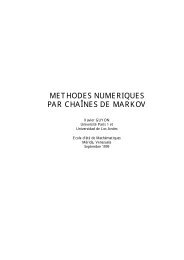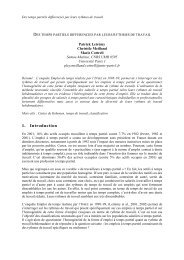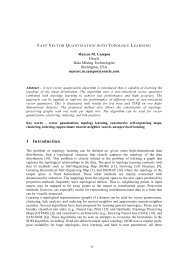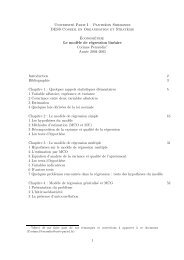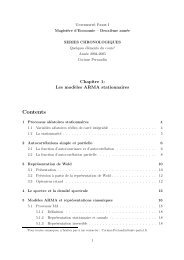Parameter estimation for stochastic equations with ... - samos-matisse
Parameter estimation for stochastic equations with ... - samos-matisse
Parameter estimation for stochastic equations with ... - samos-matisse
Create successful ePaper yourself
Turn your PDF publications into a flip-book with our unique Google optimized e-Paper software.
<strong>Parameter</strong> <strong>estimation</strong> <strong>for</strong> <strong>stochastic</strong> <strong>equations</strong><br />
<strong>with</strong> additive fractional Brownian sheet<br />
Tommi Sottinen ∗ Ciprian A. Tudor †<br />
November 18, 2005<br />
Abstract<br />
We study the maximum likelihood estimator <strong>for</strong> <strong>stochastic</strong> <strong>equations</strong> <strong>with</strong> additive<br />
fractional Brownian sheet. We use the Girsanov trans<strong>for</strong>m <strong>for</strong> the the<br />
two-parameter fractional Brownian motion, as well as the Malliavin calculus and<br />
Gaussian regularity theory.<br />
Mathematics Subject Classification (2000):<br />
60G15, G0H07, 60G35, 62M40<br />
Key words and phrases: maximum likelihood estimator, fractional Brownian sheet,<br />
Malliavin calculus, Girsanov trans<strong>for</strong>m<br />
1 Introduction<br />
The recent development in the <strong>stochastic</strong> calculus <strong>with</strong> respect to the fractional<br />
Brownian motion has led to the study of parameter <strong>estimation</strong> problems <strong>for</strong> <strong>stochastic</strong><br />
<strong>equations</strong> driven by this process. Several authors has studied these aspects;<br />
see e.g. [6, 7, 13, 8, 19]. An obvious extension is to study the two-parameter case.<br />
Elements of the <strong>stochastic</strong> calculus <strong>with</strong> respect to the fractional Brownian sheet has<br />
recently been considered by [17, 18] and <strong>stochastic</strong> <strong>equations</strong> <strong>with</strong> fractional Brownian<br />
sheet has emerged in [3] and [15].<br />
The aim of this work is to construct the maximum likelihood estimator (MLE)<br />
<strong>for</strong> the parameter θ in the equation<br />
X t,s = θ<br />
∫ t ∫ s<br />
0<br />
0<br />
b(X v,u ) dudv + W α,β<br />
t,s , t, s ∈ [0, T ],<br />
where W α,β is a fractional Brownian sheet <strong>with</strong> Hurst parameters α, β ∈ (0, 1) and<br />
b is a Lipschitz function. Our construction of the estimator is based on the Girsanov<br />
trans<strong>for</strong>m and uses the connection between the fractional Brownian sheet and the<br />
∗ Department of Mathematics and Statistics, University of Helsinki, P.O. Box 68, 00014 University<br />
of Helsinki, Finland, tommi.sottinen@helsinki.fi<br />
† SAMOS-MATISSE, Université de Panthéon-Sorbonne Paris 1, 90, rue de Tolbiac, 75634 Paris<br />
Cedex 13, France, tudor@univ-paris1.fr<br />
1
standard one, Malliavin calculus, and Gaussian regularity theory. A related work on<br />
a two-parameter model <strong>with</strong> standard Brownian sheet is the paper [2].<br />
The paper is organized as follows. Section 2 contains some preliminaries on the<br />
fractional Brownian sheet. In section 3, using the techniques of the Malliavin calculus,<br />
we prove that the solution is sub-Gaussian. Section 4 contains the proof of the<br />
existence of the MLE <strong>for</strong> the parameter θ and we separate this proof following the<br />
values of α and β . Finally, in Section 5, we present a different expression of the MLE<br />
and relate our work <strong>with</strong> the approach of [7].<br />
2 Fractional Brownian sheet as a Volterra sheet<br />
We recall how the fractional Brownian sheet W α,β can be represented by a standard<br />
Brownian sheet W = W 1 2 , 1 2 that is constructed from it. For details and references<br />
see [14, 15].<br />
We start <strong>with</strong> the one-parameter case. Define a Volterra kernel (i.e. a kernel<br />
which vanishes if the second variable is greater than the first one)<br />
( ( ) t α−<br />
1<br />
∫ )<br />
2<br />
K α (t, s) = c α (t − s)<br />
α− 1 1<br />
t<br />
2 − (α −<br />
s<br />
2 )s 1 2 −α u α− 3 2 (u − s)<br />
α− 1 2 du ,<br />
where the normalising constant is<br />
√<br />
(2α + 1 2<br />
c α =<br />
)Γ( 1 2 − α)<br />
Γ(α + 1 2<br />
)Γ(2 − 2α)<br />
and Γ is the Euler’s gamma function. It was shown in [10] that the fractional Brownian<br />
motion W α <strong>with</strong> Hurst index α ∈ (0, 1) can be represented by using a standard<br />
Brownian motion W = W 1 2 as<br />
W α t =<br />
∫ t<br />
0<br />
K α (t, s) dW s .<br />
This Wiener integral can be understood both in pathwise and L 2 -sense. The Brownian<br />
motion W is actually constructed from the fractional one by the (pathwise or<br />
L 2 ) integral<br />
Here the Volterra kernel K −1<br />
α<br />
Kα<br />
−1 (t, s) = c ′ α<br />
W t =<br />
is<br />
( ( t<br />
s) α−<br />
1<br />
2<br />
(t − s)<br />
1<br />
c ′ α =<br />
and B is the beta function.<br />
∫ t<br />
0<br />
K −1<br />
α (t, s) dW α s .<br />
2 −α − (α − 1 2 )s 1 2 −α ∫ t<br />
Γ(α + 1 2<br />
)Γ(2 − 2α)<br />
√<br />
,<br />
B( 1 2 − α) (2α + 1 2 )Γ( 1 2 − α)<br />
2<br />
s<br />
s<br />
u α− 3 2 (u − s)<br />
1<br />
2 −α du<br />
)<br />
,
Now we turn to the two-parameter case. Let<br />
K α,β (t, s; v, u) = K α (t, v)K β (s, u),<br />
K −1<br />
α,β<br />
(t, s; v, u) = K−1 α<br />
(t, v)K −1 (s, u).<br />
β<br />
The kernels K α,β and K −1<br />
α,β<br />
are of Volterra type: they vanish if v ≥ t or u ≥ s.<br />
Then from the one-parameter case it follows that we have the following (pathwise<br />
and L 2 -sense) trans<strong>for</strong>mations connecting the fractional Brownian sheet W α,β and<br />
the standard one W = W 1 2 , 1 2 :<br />
(2.1)<br />
(2.2)<br />
W α,β<br />
t,s =<br />
W t,s =<br />
∫ t ∫ s<br />
0 0<br />
∫ t ∫ s<br />
0<br />
0<br />
K α,β (t, s; v, u) dW u,v ,<br />
K −1<br />
α,β<br />
α,β<br />
(t, s; v, u) dWu,v .<br />
We shall use this connection in the following way: The fractional Brownian sheet<br />
W α,β is assumed to be given, the standard Brownian sheet W is constructed from<br />
the fractional one W α,β by the <strong>for</strong>mula (2.2), and then W α,β is represented in terms<br />
of W by the <strong>for</strong>mula (2.1).<br />
In what follows we shall denote by K α,β also the operator on L 2 ([0, T ] 2 ) induced<br />
by the kernel K α,β :<br />
K α,β [f](t, s) =<br />
∫ t ∫ s<br />
0<br />
0<br />
K α,β (t, s; v, u)f(v, u) dudv,<br />
and similarly <strong>for</strong> K −1<br />
α,β<br />
. Note that as an operator K−1<br />
α,β<br />
is indeed the inverse of the<br />
operator K α,β .<br />
Finally, we note the following connection <strong>with</strong> deterministic fractional calculus.<br />
The fractional Riemann–Liouville integral of order γ > 0 is<br />
I γ [f](t) = 1<br />
Γ(γ)<br />
∫ t<br />
0<br />
(t − v) γ−1 f(v) dv.<br />
The fractional Weyl derivative of order γ ∈ (0, 1) is<br />
[ ∫<br />
I −γ 1 f(t) t<br />
]<br />
f(t) − f(v)<br />
[f](t) =<br />
Γ(1 − γ) t γ + γ<br />
(t − v) γ+1 dv .<br />
The mixed fractional integral–differential operator I γ,η acts on two-argument functions<br />
f = f(t, s) argumentwise: I γ,η [f](t, s) = I γ [f η (·, s)](t), where f η (t, s) =<br />
I η [f(t, ·)](s). Now, we have the representation (see [3])<br />
[<br />
]<br />
(2.3) K −1<br />
α,β [f](t, s) = c′′ α,β tα− 1 2 s<br />
β− 1 1<br />
2 I 2 −α, 1 2 −β t 1 2 −α s 1 2 −β ∂2 f<br />
(t, s),<br />
∂t∂s<br />
0<br />
where c ′′ α,β<br />
is a certain normalising constant.<br />
3
3 On the solution<br />
Now we shall focus our attention to the <strong>stochastic</strong> differential equation<br />
(3.1) X t,s = θ<br />
∫ t ∫ s<br />
0<br />
0<br />
b(X v,u ) dudv + W α,β<br />
t,s , t, s ∈ [0, T ].<br />
The equation (3.1) has been considered in [3] <strong>for</strong> parameters (α, β) ∈ (0, 1 2 )2 in<br />
the more general context b(x) = b(t, s; x) <strong>with</strong> t, s ∈ [0, T ]. It has been proved that,<br />
if b satisfy the linear growth condition<br />
|b(t, s; x)| ≤ C(1 + |x|)<br />
then (3.1) admits a unique weak solution, and if b is nondecreasing in the second<br />
variable and bounded, then (3.1) has a unique strong solution.<br />
We are here interesting in the case when the drift coefficient b is Lipschitz (more<br />
exactly, we will assume that b is differentiable <strong>with</strong> bounded derivative). It is clear<br />
that in this case the method of standard Picard iterations can be applied to obtain the<br />
existence and the uniqueness of the solution <strong>for</strong> all Hurst parameters α, β belonging<br />
to (0, 1). As far as we know there are not existence and uniqueness results in the<br />
non-Lipschitz case if α or β are bigger than 1 2 .<br />
Since our main objective is the construction of a maximum likehood estimator<br />
from the observation of the trajectory of the process X that satisfies (3.1), we will<br />
need some estimates on the supremum of this processes, and even more generally,<br />
on the variations of this process. For this purpose, we follow the ideas developped<br />
in [19] to prove that the solution of (3.1) is a sub-Gaussian process <strong>with</strong> respect to<br />
a certain canonical metric. The proof is based on the Poincaré inequality and uses<br />
some elements of the Malliavin calculus.<br />
We make the following assumption on the drift b throughout the rest of the paper:<br />
(C1)<br />
b is differentiable <strong>with</strong> bounded derivative.<br />
Denote by D the Malliavin derivative <strong>with</strong> respect to the Brownian sheet W . We<br />
refer to [11] details of Malliavin calculus and just recall two basic facts:<br />
(i) If F is a Wiener integral of the <strong>for</strong>m<br />
<strong>with</strong> f ∈ L 2 ([0, T ] 2 ) then<br />
F =<br />
∫ T ∫ T<br />
0 0<br />
f(t, s) dW s,t<br />
D t,s F = f(t, s).<br />
(ii) If F is a random variable differentiable in the Malliavin sense and b is a function<br />
satisfying the condition (C1) then b(F ) is Malliavin differentiable and we have<br />
the chain rule<br />
D t,s b(F ) = b ′ (F )D t,s F.<br />
4
We will need two auxiliary lemmas.<br />
3.2 Lemma. There exists a constant C θ depending on T , α, β , ‖b ′ ‖ ∞ and the<br />
parameter θ such that <strong>for</strong> every t, s ∈ [0, T ] we have the bound<br />
(3.3) ‖D·,·X t,s ‖ 2 L 2 (Ω×[0,T ] 2 ) ≤ C θ.<br />
Proof. Taking Malliavin derivatives D v,u on the both sides of the equation (3.1) we<br />
obtain<br />
Denote<br />
D v,u X t,s = θ<br />
M t,s =<br />
∫ t ∫ s<br />
v<br />
∫ T ∫ T<br />
0<br />
0<br />
u<br />
b ′ (X v ′ ,u ′)D v,uX v ′ ,u ′ du′ dv ′ + K α,β (t, s; v, u).<br />
|D v,u X t,s | 2 dudv =<br />
∫ t ∫ s<br />
0<br />
0<br />
|D v,u X t,s | 2 dudv.<br />
Then, by Fubini theorem and the estimate (x + y) 2 ≤ 2x 2 + 2y 2 , we obtain<br />
M t,s = θ 2 ∫ t<br />
≤<br />
≤<br />
0<br />
2θ 2 ∫ t<br />
+2<br />
∫ s<br />
∣<br />
0<br />
∫ s<br />
0 0<br />
∫ t ∫ s<br />
0<br />
2θ 2 ‖b ′ ‖ 2 ∞<br />
= 2θ 2 ‖b ′ ‖ 2 ∞<br />
= 2θ 2 ‖b ′ ‖ 2 ∞<br />
∫ t ∫ s<br />
v u<br />
∫ t ∫ s<br />
∣<br />
v<br />
0<br />
∫ t ∫ s<br />
u<br />
b ′ (X v ′ ,u ′)D v,uX v ′ ,u ′ du′ dv ′ + K α,β (t, s; v, u)<br />
∣<br />
b ′ (X v ′ ,u ′)D v,uX v ′ ,u ′ du′ dv ′ ∣ ∣∣∣<br />
2<br />
dudv<br />
K α,β (t, s; v, u) 2 dudv<br />
0 0<br />
∫ t ∫ s<br />
0 0<br />
∫ t ∫ s<br />
0<br />
0<br />
{∫ t<br />
v<br />
{ ∫ v ′<br />
0<br />
∫ s<br />
u<br />
∫ u ′<br />
0<br />
} ∣<br />
∣ Dv,u X v ′ ,u 2 ′ du ′ dv ′ dudv + 2t 2α s 2β<br />
∣ Dv,u X v ′ ,u ′ ∣ ∣<br />
2 dudv<br />
}<br />
du ′ dv ′ + 2t 2α s 2β<br />
M v ′ ,u ′ du′ dv ′ + 2t 2α s 2β .<br />
So, the claim follows by a two-parameter version of the Gronwall lemma.<br />
2<br />
dudv<br />
3.4 Lemma. Let X be the unique solution of (3.1). Then there exists a constant C θ<br />
depending on T , α, β , ‖b ′ ‖ ∞ and the parameter θ such that <strong>for</strong> every s ≤ s ′ , t ≤ t ′<br />
it holds that<br />
(3.5) ‖D·,·<br />
(<br />
Xt ′ ,s ′ − X t,s)<br />
‖<br />
2<br />
L 2 (Ω×[0,T ] 2 ) ≤ C θ(|t − t ′ | 2α + |s − s ′ | 2β ).<br />
Proof. For every s ≤ s ′ and t ≤ t ′ , we have<br />
So, it is enough to show that<br />
X t ′ ,s ′ − X t,s = X t ′ ,s ′ − X t,s ′ + X t,s ′ − X t,s.<br />
(3.6) ‖D·,·<br />
(<br />
Xt ′ ,s ′ − X t,s ′ )<br />
‖<br />
2<br />
L 2 (Ω×[0,T ] 2 ) ≤ C θ(|t − t ′ | 2α ).<br />
5
Now<br />
and thus<br />
X t ′ ,s ′ − X t,s ′ = θ ∫ t ′<br />
D a,b<br />
[<br />
Xt ′ ,s ′ − X t,s ′ ]<br />
t<br />
∫ s ′<br />
0<br />
b(X v,u ) dudv + W α,β<br />
t ′ ,s<br />
− W α,β<br />
′ t,s ′<br />
∫ t ′ ∫ s ′<br />
= θ b ′ (X v,u )D a,b X v,u dudv<br />
t 0<br />
(<br />
)<br />
+K β (s ′ , b) K α (t ′ , a) − K α (t, a) .<br />
By using the fact that<br />
∫ T<br />
we obtain<br />
[∫ T<br />
E<br />
≤<br />
≤<br />
0<br />
∫ T<br />
0<br />
⎡<br />
2θ 2 E ⎣<br />
∣<br />
0<br />
(<br />
Kα (t ′ , a) − K α (t, a) ) 2 da = |t ′ − t| 2α<br />
]<br />
∣ [<br />
∣D a,b Xt ′ ,s ′ − X ]∣<br />
t,s ∣<br />
2 ′ dbda<br />
∫ t ′ ∫ s ′<br />
t<br />
0<br />
b ′ (X v,u )D a,b X v,u dudv<br />
∣<br />
2<br />
⎤<br />
dbda⎦ + 2(s ′ ) 2β |t ′ − t| 2α<br />
[∫ T ∫ T<br />
]<br />
2θ 2 ‖b ′ ‖ 2 ∞E |D a,b X v,u | 2 dbda (t − t ′ ) 2 + 2(s ′ ) 2β |t ′ − t| 2α .<br />
0 0<br />
The claim follows now from Lemma 3.2 and the fact that α, β < 1.<br />
Recall that a sheet X is sub-Gaussian <strong>with</strong> respect to metric δ if <strong>for</strong> all λ ∈ R<br />
E [ exp { λ ( { }<br />
)}] λ<br />
2<br />
X t,s − X t ′ ,s ′ ≤ exp<br />
2 δ(t, s; t′ , s ′ ) 2 .<br />
3.7 Proposition. Suppose that b satisfies condition (C1). Then the solution X of<br />
(3.1) is a sub-Gaussian process <strong>with</strong> respect to the metric δ given by<br />
δ(t, s; t ′ , s ′ ) 2 = C θ<br />
(|t − t ′ | 2α + |s − s ′ | 2β) ,<br />
where the constant C θ comes from Lemma 3.4.<br />
Proof. Recall the Poincaré inequality (see [20], page 76): if F is a functional of the<br />
Brownian sheet W , then<br />
[ { }]<br />
π<br />
2<br />
E [exp{F }] ≤ E exp<br />
8 ‖DF ‖2 L 2 ([0,T ] 2 )<br />
.<br />
The claim follows from this and Lemma 3.4.<br />
Proposition 3.7 says that, in the case of the Lipschitz coefficient b, the variations<br />
of the process X are dominated, in distribution, by those of the Gaussian process<br />
6
<strong>with</strong> canonical metric (3.7); this prcosess is actually the so-called isotropic fractional<br />
Brownian sheet. As a consequence, the sub-Gaussian regularity theory (see [4] or [9])<br />
can be applied to obtain supremum estimates on the process X . As an immediate<br />
consequence, we get, using the results in [9], Chapter 12 and the methods in [19]).<br />
[<br />
]<br />
(3.8) E<br />
sup |X v,u |<br />
v≤t,u≤s<br />
≤ C θ<br />
√t 2α + s 2β .<br />
and, <strong>for</strong> any positive a θ = a(α, β, T, ‖b ′ ‖ ∞ , θ) small enough,<br />
[ {<br />
(3.9) E<br />
exp<br />
a θ<br />
}]<br />
sup |X t,s | 2 < ∞.<br />
t,s∈[0,T ]<br />
These estimates will be explicitly used in the next section.<br />
4 Maximum likelihood estimator<br />
First we recall how the Girsanov theorem <strong>for</strong> the shifted fractional Brownian sheet<br />
(4.1) ˜W<br />
α,β<br />
t,s<br />
= W α,β<br />
t,s +<br />
∫ t ∫ s<br />
0<br />
0<br />
a u,v dudv<br />
can be recovered from the Girsanov theorem <strong>for</strong> the standard shifted Brownian sheet<br />
by the correspondence (2.1)–(2.2).<br />
Since the shift term in (4.1) is differentiable we can operate pathwise <strong>with</strong> the<br />
kernel K −1<br />
α,β<br />
on the both sides of the equation (4.1). So, we can set<br />
(4.2) ˜Wt,s =<br />
∫ t ∫ s<br />
0<br />
0<br />
K −1<br />
α,β<br />
α,β<br />
(t, s; v, u) d ˜W u,v<br />
and we have the following inverse relation <strong>for</strong> the transfer (4.2):<br />
(4.3) ˜W<br />
α,β<br />
t,s =<br />
∫ t ∫ s<br />
Now we want to find a shift b such that<br />
(4.4) ˜Wt,s = W t,s +<br />
0<br />
0<br />
K α,β (t, s; v, u) d ˜W u,v .<br />
∫ t ∫ s<br />
0<br />
0<br />
b v,u dudv,<br />
where W is a standard Brownian sheet constructed from the fractional one W α,β by<br />
(4.5) W t,s =<br />
∫ t ∫ s<br />
0<br />
0<br />
K −1<br />
α,β<br />
α,β<br />
(t, s; v, u) dWu,v .<br />
Comparing <strong>equations</strong> (4.1)–(4.5) we see that the connection is<br />
∫ t ∫ s<br />
0<br />
0<br />
a v,u dudv =<br />
∫ t<br />
0<br />
K α,β (t, s; v, u)b v,u dudv<br />
7
So, we conclude that<br />
(4.6) b t,s =<br />
∫ t ∫ s<br />
or, in operator notation,<br />
0<br />
0<br />
K −1<br />
α,β (t, s; v, u) (∫ v<br />
b = K −1<br />
α,β<br />
[∫ ·<br />
0<br />
∫ ·<br />
0<br />
0<br />
∫ u<br />
0<br />
]<br />
a t,s dsdt .<br />
a v ′ ,u ′ du′ dv ′ )<br />
dudv<br />
Now, comparing (4.1) to (4.4) <strong>with</strong> the connection (4.6) we obtain the following<br />
Girsanov theorem from the classical Girsanov theorem <strong>for</strong> the shifted standard<br />
Brownian sheet.<br />
4.7 Theorem. Let W α,β be a fractional Brownian sheet and let a be a process<br />
adapted to the filtration generated by W α,β . Let W be a standard Brownian sheet<br />
constructed from W α,β by (2.2) and let b b constructed from a by (4.6).<br />
Assume that b ∈ L 2 (Ω × [0, T ] 2 ), and E[V T,T ] = 1 where<br />
{ ∫ T ∫ T<br />
V T,T = exp − b t,s dW s,t − 1 ∫ T ∫ T<br />
}<br />
b 2 t,s dsdt .<br />
2<br />
0<br />
0<br />
Then under the new probability ˜P <strong>with</strong> d ˜P<br />
dP = V T,T the process ˜W given by (4.2) is a<br />
Brownian sheet and the process ˜W α,β given by (4.1) is a fractional Brownian sheet.<br />
The rest of this paper is devoted to construct a maximum likelihood estimator<br />
<strong>for</strong> the parameter θ in (3.1) by using the Girsanov theorem (Theorem 4.7). The<br />
existence and the expression of this MLE are given by the following result.<br />
4.8 Proposition. Assume that one of the following holds:<br />
(i) At least one of the parameters α and β belongs to (0, 1 2<br />
) and b satisfies (C1)<br />
(ii) The parameters α and β both belong to ( 1 2<br />
, 1) and b is linear.<br />
Denote<br />
(4.9) Q t,s = K −1<br />
α,β<br />
[∫ ·<br />
0<br />
∫ ·<br />
0<br />
]<br />
b(X v,u ) dudv (t, s).<br />
Then given observation over [0, t] 2 the MLE <strong>for</strong> θ in (3.1) is<br />
(4.10) θ t = −<br />
∫ t ∫ t<br />
0<br />
∫ t<br />
0<br />
0<br />
0 Q v,u dW u,v<br />
∫ t<br />
0 Q2 v,u dudv .<br />
Be<strong>for</strong>e going into the proof of Proposition 4.8 let us note that we can also write<br />
(4.11) θ t =<br />
∫ t ∫ t<br />
0<br />
∫ t<br />
0<br />
0 Q v,u d ˜W u,v<br />
∫ t<br />
0 Q2 v,u dudv .<br />
This shows that the estimator can be deduced by the observed process X since<br />
˜W t,s =<br />
∫ t ∫ s<br />
0<br />
0<br />
K −1<br />
α,β (t, s; v, u)dX u,v.<br />
0<br />
8
Proof. Let us denote by P θ the law of the process X t,s that is the unique solution<br />
of (3.1). Then the MLE is obtained by taking the sup θ F θ , where<br />
F θ = dP θ<br />
dP 0<br />
.<br />
The conclusion (4.9) then follows by the Girsanov theorem (Theorem 4.7) if we show<br />
that V t,t is well-defined and E[V t,t ] = 1. The proof is separated into three cases. In<br />
what follows c α,β is a generic constant depending on α and β that may change even<br />
<strong>with</strong>in a line.<br />
The case α, β ∈ (0, 1 2 ): In this case we use the expression (2.3) <strong>with</strong> Iα− 1 2 ,β− 1 2 as<br />
a double fractional integral. We get<br />
Q t,s = c α,β t α− 1 2 s<br />
β− 1 2<br />
∫ t ∫ s<br />
0<br />
0<br />
(t − v) − 1 2 −α v 1 2 −α (s − u) − 1 2 −β u 1 2 −β b(X u,v ) dudv.<br />
Since |b(x)| ≤ |b(x) − b(0)| + |b(0)| ≤ K(|x| + K ′ ), we see that<br />
)<br />
(4.12) |Q t,s | ≤ c α,β<br />
(K + sup |X u,v |<br />
u≤t,v≤s<br />
Clearly (4.12) and the estimates (3.8), (3.9) show that Q ∈ L 2 ([0, T ] 2 ) and so V t,t is<br />
well-defined. To prove that E[V t,t ] = 1, it suffices to invoke Theorem 1.1, page 152<br />
in [5] and to note that, by (4.12), there exists a > 0 such that<br />
sup E [ exp { aQ 2 v,u}]<br />
< ∞.<br />
v≤t,u≤s<br />
.<br />
The case α, β ∈ ( 1 2 , 1): In this case we use the operator Iα− 1 2 ,β− 1 2<br />
(2.3) is a double fractional derivative. We get<br />
in the expression<br />
Q t,s = c α,β t 1 2 −α s 1 2 −β b(X t,s ) + c α,β t α− 1 2 s<br />
1<br />
2 −β ∫ t<br />
∫ s<br />
0<br />
t 1 2 −α b(X t,s ) − v 1 2 −α b(X v,s )<br />
dv<br />
(t − v) α+ 1 2<br />
+c α,β t 1 2 −α s β− 1 s 1 2 −β b(X t,s ) − u 1 2 −β b(X t,u )<br />
2<br />
du<br />
0 (s − u) β+ 1 2<br />
∫ t ∫ s {<br />
+c α,β t 1 2 −α v 1 2 −β b(X t,s ) − v 1 2 −α v 1 2 −β b(X v,s ) − t 1 2 −α u 1 2 −β b(X t,u )<br />
0<br />
0<br />
} (<br />
)<br />
+v 1 2 −α u 1 2 −β b(X v,u ) (t − v) −α− 1 2 (s − u)<br />
−β− 1 2 dudv<br />
:= A 1 (t, s) + A 2 (t, s) + A 3 (t, s) + A 4 (t, s).<br />
The term A 1 (t, s) can be easily treated, since by (C1),<br />
|A 1 (t, s)| ≤ c α,β t 1 2 −α s 1 2 −β (K + ‖X‖ ∞ )<br />
which is finite by (4.12). The term A 2 (t, s) and A 3 (t, s) are rather similar to those<br />
appearing in the one-parameter case (see [12] and [19]). For the sake of completeness,<br />
9
we illustrate how to treat them. For A 2 (t, s) write<br />
Since<br />
∫<br />
A 2 (t, s) = c α,β t α− 1 1<br />
t<br />
2 s 2 −β t 1 2 −α − v 1 2 −α<br />
b(X t,s )<br />
dv<br />
0 (t − v) α+ 1 2<br />
+c α,β t α− 1 2 s<br />
1<br />
2 −β ∫ t<br />
=: A 21 (t, s) + A 22 (t, s).<br />
∫ t<br />
0<br />
0<br />
b(X t,s ) − b(X v,s )<br />
dv<br />
(t − v) α+ 1 2<br />
t 1 2 −α − u 1 2 −α<br />
dv = c<br />
(t − v) α+ 1 α,β t 1−2α ,<br />
2<br />
the summand A 21 (t, s) is clearly almost surely finite using condition (C1). The second<br />
summand A 22 can be bounded as follows: <strong>for</strong> ε small enough,<br />
[ ] ∫<br />
|A 2,2 (t, s)| ≤ c α,β t α− 1 1<br />
2 s 2 −β |Xt,s − X v,s | t<br />
sup<br />
(t − v) α−ε u 1 2 −α (t − v) − 1 2 −ε dv<br />
v≤t<br />
By the Fernique theorem the supremum above has exponential moments. So, it<br />
follows that the Novikov criterium is satisfied. Let us study now the term A 4 (t, s).<br />
It is not difficult to see that the expression<br />
I = t 1 2 −α s 1 2 −β b(X t,s ) − v 1 2 −α s 1 2 −β b(X v,s )<br />
−t 1 2 −α u 1 2 −β b(X t,u ) + u 1 2 −α u 1 2 −β b(X v,u )<br />
0<br />
can be written as<br />
I =<br />
(<br />
t 1 2 −α − u 1 −α) 2 b(X t,s )<br />
(s 1 2 −β − v 1 −β) 2<br />
(<br />
+ t 1 2 −α − u 1 −α) 2 v 1 −β( )<br />
2 b(X t,s ) − b(X t,v )<br />
(<br />
+u 1 2 −α s 1 2 −β − v 1 −β) ( )<br />
2 b(X t,s ) − b(X u,s )<br />
+u 1 2 −α v 1 −β( )<br />
2 b(X t,s ) − b(X t,v ) − b(X u,s ) + b(X u,v ) .<br />
This gives a decomposition of the term A 4 (t, s) in four summands; The first three<br />
summands can be handled by using similar arguments to those already used throughout<br />
this proof. For the last term actually we need to assume the linearity of the<br />
function b (and obviously the solution of (3.1) is then Gaussian). If b is linear, then<br />
b(X t,s ) − b(X t,u ) − b(X v,s ) + b(X v,u )<br />
= X t,s − X t,u − X v,s + X v,u<br />
=<br />
∫ t ∫ s<br />
v u<br />
X b,a dbda + W α,β ((z, z ′ ])<br />
10
where W α,β ((z, z ′ ]) denotes the planar increments of W α,β between z = (v, u) and<br />
z ′ = (t, s). We finish again by an application of the Fernique theorem and observing<br />
that the process W α,β (and thus X ) is Hölder continuous of order (α, β) (see<br />
Proposition 5 in [1]).<br />
The case α ∈ (0, 1 2 ), β ∈ ( 1 2<br />
, 1): In this case, it is not difficult to see that<br />
Q t,s = c α,β t α− 1 2<br />
×<br />
[<br />
∫ t<br />
0<br />
(t − v) −α− 1 2 v<br />
1<br />
2 −α<br />
s 1 2 −β b(X v,s ) + c α,β s β− 1 2<br />
∫ s<br />
0<br />
]<br />
b(X v,s )s 1 2 −β − b(X v,u )u 1 2 −β<br />
du dv.<br />
(s − u) 1 2 +β<br />
Clearly, this case can be handled by combining the methods used in the first two<br />
cases. The only thing we need to note here is that the Fernique theorem holds <strong>for</strong><br />
the sub-Gaussian process X (actually, here we can use the fact that <strong>for</strong> each v , the<br />
process s ↦→ X v,s is sub-Gaussian <strong>with</strong> respect the metric |s ′ − s| β , see the proof of<br />
Lemma 2).<br />
5 Alternative <strong>for</strong>m of the estimator<br />
We will try to relate here our approach <strong>with</strong> the one considered by [7] in the oneparameter<br />
scale.<br />
As in the one -parameter case (see [10]) one can associate to the fractional Brownian<br />
sheet a two-parameter martingale (the so-called fundamental martingale). We<br />
refer to [16] <strong>for</strong> the two-parameter case. More precisely, let us define the deterministic<br />
function<br />
k α (t, u) = c −1<br />
α u 1 2 −α (t − u) 1 2 −α , c α = 2αΓ( 3 2 − α)Γ(α + 1 2 )<br />
and<br />
Then the process<br />
ω α t<br />
= λ −1<br />
α t 2−2α , λ α = 2Γ(3 − 2α)Γ(α + 1 2 )<br />
Γ( 3 2 − α) .<br />
(5.1) M α,β<br />
t,s =<br />
∫ t ∫ s<br />
0<br />
0<br />
k α (t, v)k β (s, u) dW α,β<br />
u,v<br />
is a two-parameter Gaussian (strong) martingale <strong>with</strong> quadratic variation equal to<br />
ωt α ωs<br />
β (the <strong>stochastic</strong> integral in (5.1) can be defined in a Wiener sense <strong>with</strong> respect<br />
to the fractional Brownian sheet). The filtration generated by M α,β coincides to the<br />
one generated by W α,β .<br />
Let us integrate the deterministic kernel k α (t, v)k β (s, u) <strong>with</strong> respect to both sides<br />
11
of (3.1). We get<br />
(5.2)<br />
Z t,s :=<br />
=<br />
∫ t ∫ s<br />
0 0<br />
∫ t ∫ s<br />
0<br />
0<br />
k α (t, v)k β (s, u) dX v,u<br />
k α (t, v)k β (s, u)b(X v,u ) dudv + M α,β<br />
t,s .<br />
5.3 Remark. Moreover, <strong>for</strong> α, β > 1 2<br />
, it follows from [6] and [16] that if we denote<br />
then it holds that<br />
(5.4) X t,s =<br />
Denote<br />
(5.5) R t,s = d<br />
dω α t<br />
Then we have the following:<br />
K α (t, v) = α(2α − 1)<br />
d<br />
dω β s<br />
∫ t ∫ s<br />
0<br />
0<br />
∫ t ∫ s<br />
0<br />
∫ t<br />
v<br />
r 2α−1 (r − v) α− 3 2 dr<br />
K α (t, v)K β (s, u) dZ u,v .<br />
0<br />
k α (t, v)k β (s, u)b(X v,u ) dudv.<br />
• For every (α, β) ∈ (0, 1) 2 and if b is Lipschitz, the sample paths of the process R<br />
given by (5.5) belong to L 2 ([0, 1] 2 , ω α ⊗ ω β ). This can be viewed in the same<br />
way as in Theorem 2.<br />
• Clearly, the process R is related to the process Q (4.9) by<br />
(5.6) R t,s = c α,β t α− 1 2 s<br />
β− 1 2 Qt,s .<br />
¿From (5.2) and (5.5) we obtain that<br />
(5.7) Z t,s = θ<br />
∫ t ∫ s<br />
0<br />
0<br />
R v,u dω β udω α v + M α,β<br />
t,s .<br />
and then the MLE <strong>for</strong> the parameter θ in (3.1) can be written as<br />
(5.8) θ t = −<br />
∫ t ∫ t<br />
0<br />
∫ t<br />
0<br />
0 R v,u dMu,v<br />
α,β<br />
∫ t<br />
0 R2 v,u dωudω β v<br />
α<br />
As a final remark, we derive an easier expression <strong>for</strong> the process R (or, equivalently,<br />
<strong>for</strong> the process Q) appearing in the expression of the MLE in the linear case.<br />
In this case we have<br />
(5.9) R t,s = d<br />
dω α t<br />
d<br />
dω β s<br />
∫ t ∫ s<br />
0<br />
0<br />
k α (t, v)k β (s, u)X v,u dudv.<br />
We need first a more suitable expression of the process R given by (5.9).<br />
.<br />
12
5.10 Proposition. For every α, β it holds that<br />
(5.11) R t,s = λ∗ α<br />
2<br />
<strong>with</strong> λ ∗ α =<br />
λα<br />
2(1−α) .<br />
λ ∗ β<br />
2<br />
∫ t ∫ s<br />
0<br />
0<br />
(<br />
t 2α−1 + v 2α−1) ( s 2β−1 + u 2β−1) dZ u,v<br />
Proof. We will restrict ourselves to the case α, β ≤ 1 2<br />
. By (5.4) and (5.9) it holds<br />
that<br />
∫ t ∫ s<br />
∫ t ∫ s<br />
(∫ v ∫ u<br />
)<br />
R v,u dωu β dωv α = k α (t, v)k β (s, u) K α (v, b)K β (u, a) dZ a,b dudv<br />
0 0<br />
0 0<br />
0 0<br />
where<br />
=<br />
∫ t ∫ s<br />
0<br />
0<br />
A α (b, t) =<br />
A α (b, t)A β (b, s) dZ a,b<br />
∫ t<br />
b<br />
k α (t, v)K α (v, b) dv.<br />
Let us suppose a function Φ α (b, r) such that <strong>for</strong> every b < t,<br />
Then it holds that<br />
∫ t ∫ s<br />
0 0<br />
R v,u dω β udω α v =<br />
=<br />
∫ t<br />
b<br />
∫ t ∫ s<br />
0 0<br />
∫ t ∫ s<br />
Φ α (b, r) dω α r = A α (b, t).<br />
(∫ t<br />
) (∫ s<br />
)<br />
Φ α (b, r) dωr<br />
α Φ β (a, r ′ ) dω β r ′<br />
b<br />
( ∫ r<br />
∫ r ′<br />
0 0 0 0<br />
a<br />
Φ α (b, r)Φ β (a, r ′ ) dZ a,b<br />
)<br />
dω β r ′ dω α r .<br />
dZ a,b<br />
As a consequence<br />
R t,s =<br />
∫ t ∫ s<br />
0<br />
0<br />
Φ α (t, v)Φ β (s, u) dZ u,v .<br />
On the other hand it has been proved in Lemma 3.1. of [7] that<br />
The conclusion follows easily.<br />
References<br />
Φ α (t, v) = λ∗<br />
2<br />
(<br />
t 2α−1 + v 2α−1) .<br />
[1] A. Ayache, S. Leger, M. Pontier (2002): Drap brownien fractionnaire. Potential<br />
Analysis, 17(1), pp. 31-34.<br />
[2] A. J. Dorogovcep and P.S. Knopov (1979): An estimator of a two-dimensional<br />
signal from an observation <strong>with</strong> additive random noise. Theory of Probability<br />
and Mathematical Statistics, 17, pp. 67-86.<br />
13
[3] M. Erraoui, D. Nualart and Y. Ouknine (2003): Hyperbolic <strong>stochastic</strong> partial<br />
differential <strong>equations</strong> <strong>with</strong> additive fractional Brownian sheet. Stochastic and<br />
Dynamics, 3, pp. 121-139.<br />
[4] X. Fernique (1974): Régularité des trajectoires de fonctions aléatoires gaussiennes.<br />
Lecture Notes in Mathematics (St. Flour), 480, pp. 2-95.<br />
[5] A. Frieman (1975): Stochastic differential <strong>equations</strong> and applications. Academic<br />
Press.<br />
[6] M. Kleptsyna, A. Le Breton and C. Roubaud (2000): <strong>Parameter</strong> <strong>estimation</strong> and<br />
optimal filtering <strong>for</strong> fractional type <strong>stochastic</strong> systems. Statistical Inference <strong>for</strong><br />
<strong>stochastic</strong> processes, 3, pp. 173-182.<br />
[7] M. Kleptsyna and A. Le Breton (2002): Statistical Analysis of the fractional<br />
Ornstein-Uhlenbeck process. Statistical Inference <strong>for</strong> <strong>stochastic</strong> processes, 5, pp.<br />
229-248.<br />
[8] A. Kukush, Y. Mishura and E. Valkeila (2005): Statistical inference <strong>with</strong> fractional<br />
Brownian motion. Statistical Inference <strong>for</strong> <strong>stochastic</strong> processes, 81, pp.<br />
71-93.<br />
[9] M. Ledoux and M. Talagrand (1990): Probability on Banach spaces. Springer.<br />
[10] I. Norros, E. Valkeila, J. Virtamo (1999): An elementary approach to a Girsanov<br />
<strong>for</strong>mula and other analytic results on fractional Brownian motion. Bernoulli,<br />
5(4), pp. 571-587.<br />
[11] D. Nualart (1995): The Malliavin calculus and related topics. Springer.<br />
[12] D. Nualart and Y. Ouknine (2002): Regularization of <strong>stochastic</strong> differential equation<br />
by fractional noise. Stoch. Proc. Applic., 102, pp. 103-116.<br />
[13] B.L.S. Prakasa Rao (2003): <strong>Parameter</strong> <strong>estimation</strong> <strong>for</strong> linear <strong>stochastic</strong> differential<br />
<strong>equations</strong> driven by fractional Brownian motion. Random Operators Stoch.<br />
Eqs., 11(3), pp. 229-242.<br />
[14] T. Sottinen (2003): Fractional Brownian motion in finance and queueing.<br />
Ph.D. Thesis, University of Helsinki. Introduction available electronically at<br />
ethesis.helsinki.fi/julkaisut/mat/matem/vk/sottinen/fraction.pdf<br />
[15] T. Sottinen and C.A. Tudor (2005): On the equivalence of multiparameter<br />
Gaussian processes. Journal of Theoretical Probability, to appear.<br />
[16] M. Tudor and C. Tudor (2002): On the multiparameter fractional Brownian<br />
motion. Preprint, 22 pp.<br />
[17] C.A. Tudor and F. Viens (2003): Itô <strong>for</strong>mula and local time <strong>for</strong> the fractional<br />
Brownian sheet. Electronic Journal of Probability, 8, paper 14, pp. 1-31.<br />
14
[18] C.A. Tudor and F. Viens (2004): Ito <strong>for</strong>mula <strong>for</strong> the fractional Brownian sheet<br />
using the extended divergence integral. Preprint.<br />
[19] C.A. Tudor and F. Viens (2005): Statistical Aspects of the fractional <strong>stochastic</strong><br />
calculus. Preprint.<br />
[20] A.S. Üstunel (1985): An introduction to analysis on Wiener spave. Lecture Notes<br />
in Mathematics, 1610, Springer.<br />
15


